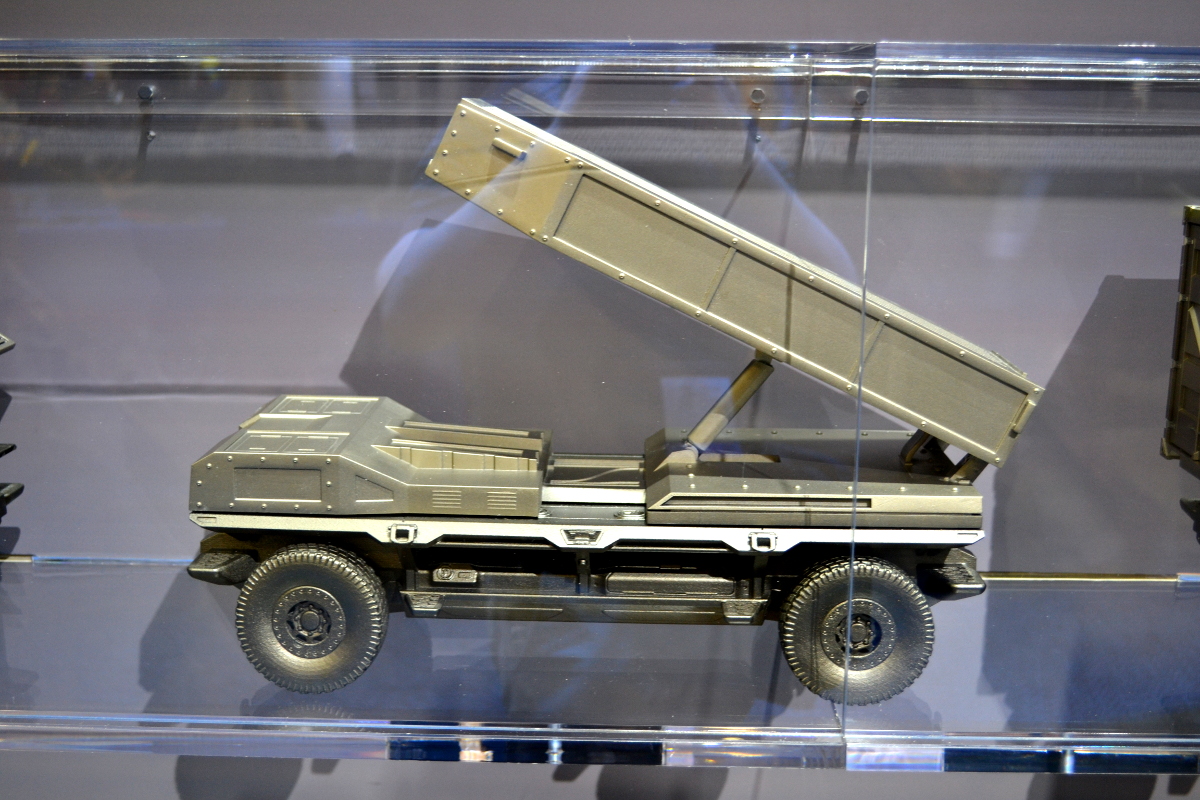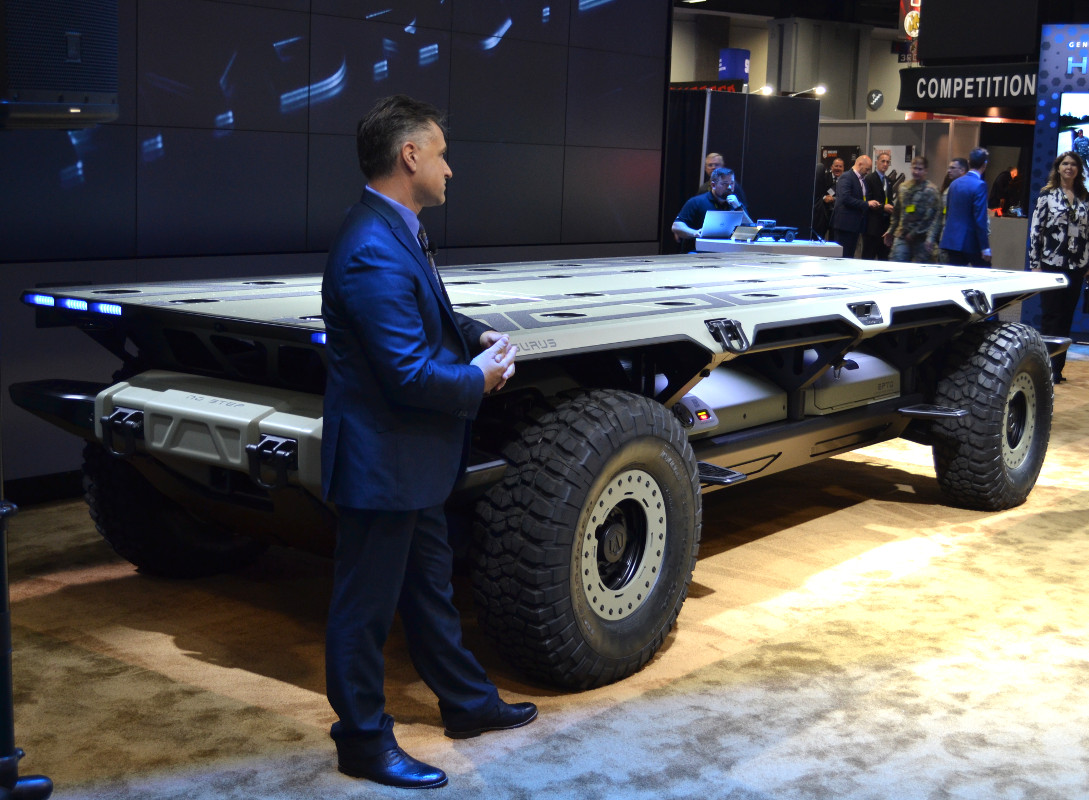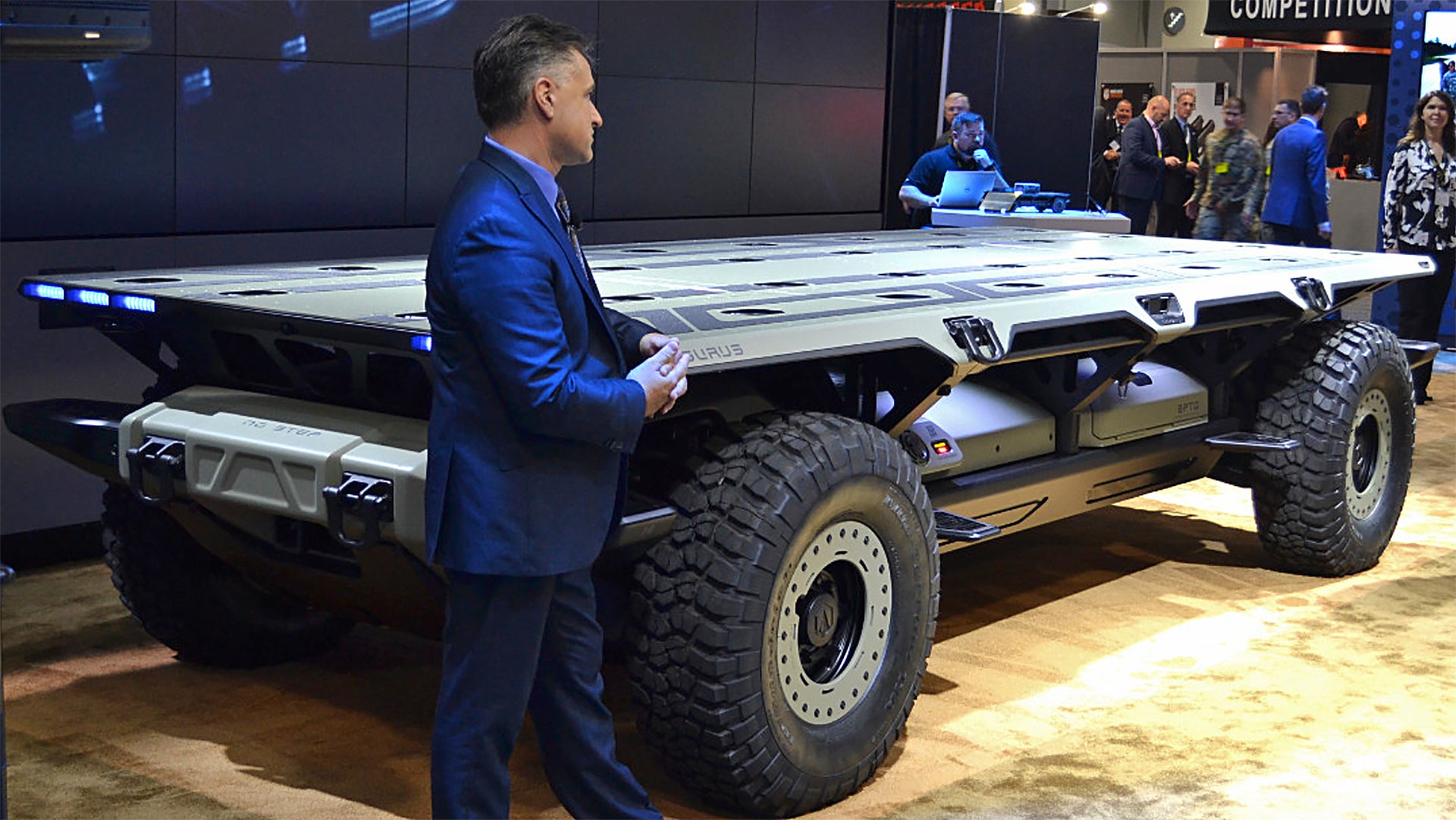At the Association of the U.S. Army’s (AUSA) 2017 annual meeting and expo, General Motors made hard pitch for its stealthy hydrogen-powered 4×4 Silent Utility Rover Universal Superstructure, which can operate in manned and unmanned modes, as a vehicle that could revolutionize how the U.S. Army fights, whether it carries cargo or a directed energy weapon. The company has already been working closely with the service on the technology, but it’s still limited by a lack of supporting infrastructure.
GM gave an in depth presentation to attendees of the event on Oct. 9, 2017, showing off a full-size mockup of the 4×4 “platform,” a chassis that can take on the various roles by simply swapping out the body kit on top. The company had revealed the system, also known as SURUS, earlier in October 2017, suggesting it would be equally useful in conflicts, after natural disasters, and for basic commercial trucking.
Still, it seems clear that the automotive firm is heavily focused on the martial applications. The vehicle’s name is a forced acronym, a reference to Surus, or “the Syrian,” a war elephant from Hannibal’s army that famously marched over the Alps against the Roman Empire at the end of the third century BC. Charlie Freese, executive director of GM’s Global Fuel Cell Business, explained at the AUSA expo that Surus had served as a platform to help the one-eyed Carthaginian general better survey the battlefield and give him and his forces an advantage over their enemies.
SURUS itself follows from an earlier collaboration between GM’s Chevrolet Division and the U.S. Army that began in October 2016. The firm had supplied a prototype hydrogen fuel cell-powered 4×4 light truck, called the ZH2, which the service had experimented with over the following 12 months.

The ZH2’s most obvious advantage over existing vehicles, such as the High Mobility Multipurpose Wheeled Vehicle, better known as the Humvee or Hummer, was the highly efficient fuel cell powerplant, which when combined with an on board battery system, produced a total of 174 horsepower over an undisclosed range. The time it took to “charge” the hydrogen fuel cell was only as long as it took an individual to fill up the fuel tanks, shorter than the average time it takes to recharge an entirely electric vehicle of similar size.
Perhaps most important, the entire arrangement is both quiet and produces relatively little heat compared to an internal combustion engine. This makes the vehicle harder for an enemy force to detect, especially at night, making it perfect for powering a stealthy surveillance vehicle. GM’s team at AUSA said that in test exercises the ZH2 prototype had been able to take Army scouts to within 330 feet of the their objective, letting them gather information and then withdraw, all without the “opposing force” ever knowing they were there.
In addition, GM made sure to give the ZH2 the ability to act as a mobile generator when not moving, able to provide 25 kilowatts of power, on par with many commercially available emergency home generators, through standard 120- and 240-volt outlets. And as a byproduct of the ZH2’s power generation process, the hydrogen from the fuel cell bonds with oxygen, producing two gallons potable drinking water per hour – explaining GM’s trademark for the technology, Hydrotec. This could easily help sustain longer patrols and other operations where small units might find themselves without direct logistical support.

All of these features carry over to the SURUS chassis, but in upgraded forms. Most importantly, GM is using a second generation fuel cell for the vehicle and has also entered into a partnership with Honda to continuing developing improved versions and produce them in the United States.
The platform itself is inherently modular and GM envisions that it will even able to accept a traditional truck body similar in basic shape to that of ZH2. However, the 4×4 light truck is by far the most basic concept the company showed at AUSA. Other variations included a manned cargo truck with a flat rear bed, as well as a robotic version to perform those duties even in dangerous situations, including combat, and help reduce the risk to drivers, both from hazards and fatigue.

With the significant on-board electricity generation, though, GM says it is interesting in promoting SURUS as an option for carrying various “power dense” equipment, including air- and surface-search radars, lasers and other directed energy weapons, and even more conventional arms such as the six-round 227mm artillery rocket launcher found on the U.S. Army’s and Marine Corps’s existing truck-mounted High Mobility Artillery Rocket Systems (HIMARS). Manned and unmanned scouts, akin to the ZH2 prototype, with a variety of high-powered sensors, including radars, electro-optical cameras, and infrared imaging systems, were another option the company proposed at AUSA.

On top of that, GM was quick to highlight the ability for commanders to use the platform’s modular nature to rapidly reconfigure it in the field. In light of recent, devastating hurricanes in the Gulf of Mexico and the Caribbean, such as Hurricane Maria, representatives pointed out that the vehicle could easily provide power generation and mobile medical facilities in an emergency. As of Oct 9, 2017, approximately 85 percent of Puerto Rico remained without power and the Federal Emergency Management Agency was still working on getting generators to the island and then to areas in need.

SURUS isn’t in a position to help out with the present disaster relief efforts, unfortunately. A lack of ready infrastructure to support hydrogen fuel cell vehicles remains a significant limiting factor and one that GM is well aware of. There still aren’t enough convenient filling stations, or the basic hydrogen fuel production capacity, to make it commercially attractive.
But when the ZH2 first appeared, Wired noted that the Army was in a potentially ideal position to make use of the technology. It is possible to convert JP-8 jet fuel, which the U.S. military already has a steady supply of in its logistics chain.
“The advantage of hydrogen is that you can get it from almost any other form of energy, renewable, grid, or conventional liquid fuels,” GM’s Freese told Wired at the time. “You could put a reformer up near forward stations, and strip the hydrogen off the JP-8.”

That process would require its own infrastructure and would still require the Army to set up its own figurative jet fuel “pipeline” for the vehicles. It would be much more likely that the service would chose to pay for hydrogen fuel made from natural gas, a much more common production method.
GM has already invested more than $2 billion in Hydrotec, hoping that eventually that infrastructure will catch up for the commercial market as it has already done for electric vehicles. Large sales to the Army or other branches of the U.S. military could definitely help drive down costs and expand both the military and commercial markets. The partnership with Honda is another important development to distribute the burden of both research and development and production.

At the same time, though, electric car manufacturers, notably Elon Musk’s Tesla, are also looking to expand their businesses into producing larger commercial trucks, which could easily have similar military applications. Those developments could have an inherent advantage over hydrogen powered vehicles because of the advanced state of existing infrastructure, including high density battery production and charging station designs.
GM definitely appears to be pushing for military contracts to keep the promising technology moving forward, but SURUS could turn out to be more like its namesake than the company might want, the last of its kind after a bold, but ultimately futile maneuver.
Contact the author: joe@thedrive.com
